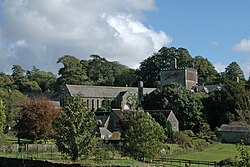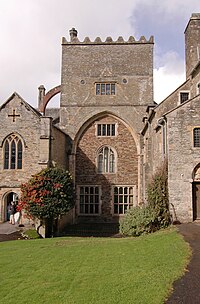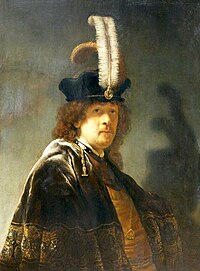Buckland Abbey
| Buckland Abbey | |
|
National Trust | |
|---|---|
 Buckland Abbey | |
| Grid reference: | SX48726676 |
| Location: | 50°28’52"N, 4°8’1"W |
| Information | |
| Website: | Buckland Abbey |
Buckland Abbey is a 700-year-old house in Buckland Monachorum, near Yelverton in Devon, noted for its connection with Sir Richard Grenville the Younger and Sir Francis Drake. Today it is in the ownership of the National Trust.
The abbey is unusual in that the church was retained as the principal component of the new house while most of the remaining monastic complex was demolished, which was a reversal of the normal way in which dissolved abbeys were converted into country mansions.
History

Buckland Abbey was originally a Cistercian abbey founded in 1278 by Amicia, Countess of Devon and was a daughter house of Quarr Abbey on the Isle of Wight. It was the last Cistercian abbey founded in England.
Grenville
The abbey passed through prosperity and poverty until the Dissolution of the Monasteries by King Henry VIII. In 1541, the King sold Buckland to Sir Richard Grenville the Elder (Sewer of the Chamber to Henry VIII, poet, soldier, and the last Earl Marshall of Calais) who, working with his son Sir Roger Greynvile (Gentleman of the Privy Chamber of Henry VIII, Captain of the ill-fated Mary Rose), began to convert the abbey into a residence, renaming it 'Buckland Greynvile'. Sir Roger died in 1545 when the Mary Rose heeled over in a sudden squall while the English Fleet was engaged with the French Fleet in the Narrow Sea off Portsmouth. Sir Richard left a son aged 3, also named Richard Grenville, who completed the conversion of the old abbey in 1575–76.
After being owned by the family for 40 years, Buckland Greynvile was sold by Sir Richard the Younger in 1581. The sale was to two intermediaries who, unbeknownst to Greynvile, were working for Francis Drake, whom Grenville despised.
Drake
Drake was already famous for his feats of war and navigation when in 1577 he set sail for a three-year voyage with six ships to raid Spanish trade on the Pacific coast of America, becoming the first Englishman to enter that ocean and thus taking the Spaniards by surprise and seizing gold-laden ships sailing for Peru. After exploring northwards, Drake sailed westward into the Pacific, capturing a treasure ship sailing for Manila, and completed his voyage home by way of the Indies, the Indian Ocean and the tip of Africa, become therefore the first captain to command a complete circumnavigation of the world. Half of the treasure won went to the Crown, and other portions to investors in the voyage; with just a fraction of his profits, Drake bought Buckland.
The original patent for such a voyage as Drake's was granted to Sir Richard Grenville, but later revoked by the Queen. This would not have improved his attitude to Drake, whom Grenville considered an upstart. For this reason, Drake has to buy Buckland through the subterfuge of two nominee intermediaries.
Drake lived in the house for 15 years, to his death off Nombre de Dios in 1596. Childless, he left the house to his brother, Thomas Drake, whose descendants owned Buckland Abbey until 1946.
In 1938 the house suffered a devastating fire. The National Trust hasve since carried out extensive restoration work, to present the house as it stood in the days of its prosperity under the Drakes and as a museum to Sir Francis Drake.
National Trust
In 1946 the house and estate were sold to a local landowner, Arthur Rodd, who presented the property to the National Trust in 1948.
The house and estate
The main house is built in what was the Cistercian church of the old abbey, and the structure of the old church shows itself throughout, though it has been thoroughly transformed within, divided by new floors and rooms to create an impressive and spacious house – which in itself emphasises how immense the original church was.
Close by is the vast barn of the abbey, largely the same as when the monks had it, and serving the same purpose under secular ownership.
Other buildings are clustered by the house and the whole is surrounded by walls, permitting kitchen gardens and horticultural gardens to thrive despite the harsh climate here at the edge of Dartmoor.
The wider estate is opened by the National Trust with a series of waymarked walks.
Drake's Drum
The collection maintained in the house is noted for Drake's Drum: the drum, bearing the arms and motto of Sir Francis Drake, which served Drake aboard his ship, the Golden Hind as it sailed around the world, and on his final voyage. In fact, that on display is a skilled replica: the original is maintained in cimate-controlled storage elsewhere. Drake's drum was sent back to Buckland Abbey after the captain's death and has since then attracted wild legends, such as that in Sir Henry Newbolt's poem Drake's Drum:
| “ | Take my drum to England, hang et by the shore, |
” |
According to legend, the drum can be heard to beat at times when England is at war or significant national events take place.[1]
Buckland today

The property has been opened to the public since 1951 and is operated by the National Trust with the assistance of the city of Plymouth: the City of Plymouth Museums and Art Museum use the building to house part of their collection.
A number of independent craft workshops are located in the converted ox sheds.
In March 2013 the portrait of a man wearing a white feathered bonnet was re-attributed to Rembrandt by the Rembrandt expert Ernst van de Wetering. In June 2014, after eight months of work at the Hamilton Kerr Institute, the painting's authenticity was confirmed and its value estimated at £30m.[2]
Costume Group
The National Trust Costume Group operate at Buckland Abbey, creating authentic Elizabethan costumes using traditional materials and methods. There is a complete Francis Drake costume, based on the famous portrait of Drake in the National Gallery, and the group are currently working on a costume for Lady Drake, also based on a portrait.
Outside links
| ("Wikimedia Commons" has material about Buckland Abbey) |
- Buckland Abbey - National Trust
References
- ↑ Drake’s Drum - xroyvision
- ↑ "Buckland Abbey Rembrandt self-portrait is genuine". 10 June 2014. http://www.bbc.co.uk/news/uk-england-devon-27763664.
